Division of Bacterial Diseases (DBD) News Bulletin
Winter 2015
In This Issue
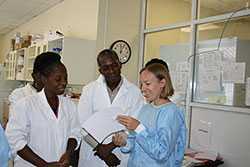
Photo: DBD’s Heidi Soeters, EIS officer, reviews lab data with microbiologists from Haiti’s Laboratoire National de Santé Publique during the 2014–2015 diphtheria outbreak in Haiti.
Meeting Highlights
Ambassador to Haiti Visits CDC
When the U.S. Ambassador to the Republic of Haiti, Peter F. Mulrean, visited CDC in October 2015, DBD staff were able to brief him on in-country collaborations and diphtheria response capacity. From December 2014 through November 2015, Haiti reported 67 cases of probable diphtheria, representing a substantial increase as compared to the past five years.
At least 20 people (30%) were reported to have died. CDC-Atlanta provided technical advice, lab-confirmed 29 cases, and provided diphtheria antitoxin to treat some cases during gaps with in-country supply. DBD staff are working with laboratory, surveillance, and vaccination staff from the Ministry of Public Health and Population, Laboratoire National de Santé Publique (National Lab), Pan American Health Organization, CDC-Haiti, and affected hospitals and departments to better understand recent diphtheria outbreaks in Haiti and to discuss potential response activities.
Legionella Program Review, Board of Scientific Counselors, and New Staff Update
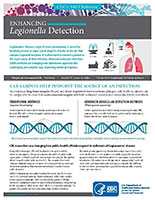
Image: New DBD fact sheet describing Legionella advanced molecular detection work.
In September 2015, NCIRD hosted a Legionella Program Review. The inter-Center review included a series of presentations by DBD’s Laurel Garrison, Preeta Kutty, Claressa Lucas, and Brian Raphael to update participants on the epidemiology of legionellosis in the United States and review the key challenges in preventing and responding to outbreaks. During a discussion facilitated by Matt Moore, this group of experts, representing a wide cross-section of multiple CDC Centers, identified and prioritized future program objectives for primary prevention and outbreak response.
In December, program staff gave a presentation to environmental and infectious disease specialists from two of CDC’s Boards of Scientific Counselors on outcomes of the program review and the division’s Legionella research and implementation agendas. In 2015, the DBD Legionella program responded to multiple Legionella outbreaks—with one in New York City being the largest community-associated Legionnaires’ disease outbreak in the United States since the pathogen was discovered in 1976.
DBD’s legionellosis team recently welcomed two new staff members: Laura Cooley, medical epidemiologist, and Brian Raphael, Legionella Laboratory lead.
Advanced Molecular Detection Day
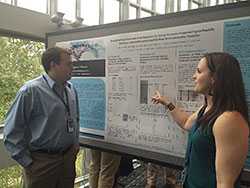
Photo: DBD’s Bernard Wolff, a microbiologist in the Pneumonia Response and Surveillance Laboratory, answers a question from DBD’s Anna Llewellyn, LLS fellow, about an unexplained respiratory disease outbreak response poster at CDC’s 2015 AMD Day.
CDC’s September 25th Advanced Molecular Detection (AMD) Day provided a forum for laboratory scientists, bioinformatics experts, and infectious disease epidemiologists to showcase the exciting accomplishments being made using AMD technologies, describe project results, discuss their AMD visions and goals, and network with colleagues. DBD was well-represented, with staff delivering two oral presentations and eight poster presentations:
Oral Presentations
During the AMD Day opening session, Bernie Beall, chief of DBD’s Streptococcus Laboratory, presented on "National surveillance for resistant invasive streptococci: S. pneumoniae, S. pyogenes, and S. agalactiae." He also presented on "High throughput characterization of invasive pneumococci employing whole genome sequencing" during the "Ignite: AMD Storytelling" session.
Poster Presentations
Al Benitez, Bernard Wolff, Maureen Diaz, et al. presented "Targeted resequencing and metagenomic analysis to identify and characterize pathogens in respiratory specimens from unexplained respiratory disease outbreak (URDO) response."
Cecilia Kretz, Ed Ramos, Fang Hu, et al. presented "Development of genomic tools for detection and characterization of bacterial meningitis pathogens."
Jeff Mercante, Natalia Kozak-Muiznieks, Shatavia Morrison, et al. presented "Strengthening outbreak investigations by using genome sequencing to rapidly subtype Legionella pneumophila from environmental sources."
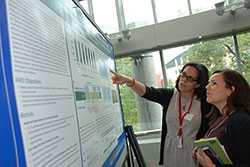
Photo: DBD’s Lucia Pawloski, a microbiologist in the Pertussis and Diphtheria Laboratory, discusses a Bordetella pertussis poster with NCEZID policy analyst, Amanda Raziano, at CDC’s 2015 AMD Day.
Ben Metcalf, Yuan Li, Sopio Chochua, et al. presented "Employing short read whole genome sequence data for invasive pneumococcal strain surveillance, investigation of disease outbreaks, and genome-wide association analyses."
Lucia Pawloski, Marsenia Harrison, Marina Chesnokova, et al. presented "The use of AMD to identify vaccine immunogen-deficient Bordetella pertussis isolates."
Adam Retchless, Fang Hu, Rasmata Traoré, et al. presented "The establishment and diversification of epidemic-associated serogroup W meningococcus in the meningitis belt."
Roman Tatusov, Ed Ramos, Cecilia Kretz, et al. presented "Comparative genomics approach for identification of serotypes/serogroups of bacterial meningitis pathogens."
Michael Weigand, Katie Bowden, Yanhui Peng, et al. presented "A history of genome structural fluidity during the resurgence of Bordetella pertussis in the United States."
IDWeek
IDWeek 2015 was held in San Diego, CA, on October 7–11, 2015. A number of DBD staff gave presentations:
- Anna Acosta (MVPDB) presented a talk on "Acellular pertussis vaccine effectiveness among children and adolescents in the setting of pertactin-deficient pertussis, Vermont, 2011–2013."
- Miwako Kobayashi (RDB) presented the poster "Outpatient antibiotic prescribing practices for uncomplicated urinary tract infections in women in the United States, 2001–2010."
- Heidi Soeters (MVPDB) presented the poster "Rapid response to a Rhode Island college outbreak of meningococcal serogroup B disease: Nation’s first widespread use of Trumenba® vaccine."
DBD staff also contributed to the following posters: "Vaccination with pneumococcal polysaccharide vaccine is associated with detection of specific pneumococcal serotypes in adults hospitalized for community-acquired pneumonia," "Third trimester Tdap immunization elicits substantial pertussis toxin IgG in neonates," and "Effectiveness of Tdap vaccination during pregnancy in preventing infant pertussis in a country with whole-cell pertussis vaccines during childhood: Preliminary results of a case-control study in Argentina."
MenAfriNet Hosted 2nd Annual Partners Meeting

Photos: Attendees of MenAfriNet’s 2nd Annual Partners Meeting (top). DBD’s Anna Acosta (right), epidemiologist, with Madame Oumou Yacouba Coulibaly, epidemiologic surveillance data manager (National level–Mali) exchange ideas at the 2015 MenAfriNet Partners Meeting in Niamey, Niger, October 2015.
MenAfriNet hosted 68 international and African partners in Niamey, Niger, for its 2nd annual meeting on October 20–22, 2015. Participants reviewed surveillance and laboratory capacity building activities and discussed lessons learned from the 2015 MenAfriNet response to the Niger serogroup C meningococcal meningitis outbreak—the largest ever epidemic of this disease serogroup.
Practitioners collaborated to develop a set of recommendations to guide MenAfriNet preparedness activities in countries at highest risk for serogroup C epidemics during the 2016 meningitis season. MVPDB’s Ryan Novak, MenAfriNet director, was joined by Anna Acosta, Flavien AKE, Oumar Diallo, Temitope Folaranmi, Rana Hajjeh, Brian Harcourt, Sarah Meyer, Stephanie Schwartz, Heidi Soeters, Ashley Tate, Tej Tiwari, and Xin Wang in coordinating and participating in the meeting.
Pertussis: Biology, Epidemiology, and Prevention Meeting
Les Pensières, Foundation Merieux hosted the Pertussis: Biology, Epidemiology, and Prevention Meeting in Veyrier-du-Lac, France, on November 11–13, 2015. The meeting brought together experts to explore the latest trends in pertussis epidemiology, discuss potential ways in which pertussis vaccines might be improved and the practicalities of their introduction into routine use, and formulate recommendations for optimal use of current vaccines. There was a particular focus on strategies to minimize severe morbidity and mortality among infants during the first months of life. Stacey Martin, Tami Skoff, and Conrad Quinn from MVPDB attended, with Martin presenting "Overview of pertussis epidemiology in the United States and impact of vaccination."
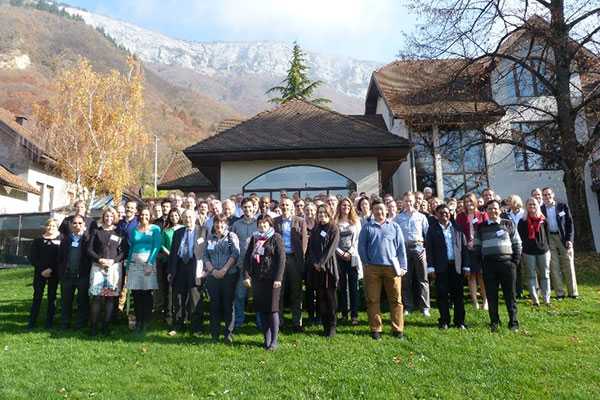
Photo: DBD’s Stacey Martin, Tami Skoff, and Conrad Quinn participated with other pertussis experts in the Pertussis: Biology, Epidemiology, and Prevention Meeting in Veyrier-du-Lac, France, in November 2015.
Global Health Security Site Visit to Burkina Faso
During the week of November 9, 2015, DBD’s Sara Mirza, Matt Moore, Heidi Soeters, and Velusamy Srinivasan met with the Burkina Faso Ministry of Health to develop the Global Health Security flagship protocol to prevent, detect, and respond to clusters of acute respiratory illness. The group also discussed next steps in the collaboration being established to evaluate the impact of PCV13 introduction in the country.
WHO Global IB-VPD Surveillance Meeting
The World Health Organization (WHO) Global Invasive Bacterial Vaccine Preventable Diseases (IB-VPD) and Rotavirus Sentinel Site Surveillance Meeting was held November 16–20, 2015, in Geneva, Switzerland, with the goal of sharing information and discussing the status and future directions of WHO-coordinated Global IB-VPD and Rotavirus Sentinel Site Surveillance Networks. DBD serves as a Global Reference Lab for this network and Jennifer Farrar, Rana Hajjeh, Mahamoudou Ouattara, Stephanie Schwartz, Chris Van Beneden, and Xin Wang participated. Through a series of presentations, the DBD team was able to demonstrate the overall progress the network has made over time (2009 to present), especially in strengthening laboratory systems at the regional level. The team also provided strategic guidance for areas of needed growth and development for future directions, such as the potential for a more targeted focus in vaccine impact studies in order to allow countries to use the data for decision-making.
CDC Public Health Grand Rounds
Conrad Quinn, MVPDB chief, presented at CDC’s December 2015 Public Health Grand Rounds on "Strengthening a Culture of Laboratory Safety." He was joined by CDC’s associate director for laboratory science Steve Monroe and Joseph Kanabrocki, as sociate vice president of research safety and professor of microbiology at the University of Chicago. In the late 1990s, the U.S. Congress mandated CDC carry out a research program on the safety and efficacy of the anthrax vaccine. In his presentation, "Quality, safety, and public health impact of laboratory science: A case study," Quinn discussed the processes the agency undertook to set up the lab responsible for studying the anthrax vaccine. He cited the leadership, specific teams and skill sets, procedures, and rigorous quality and safety controls that were required to conduct the successful anthrax vaccine clinical trial. He cited these as examples of the investments needed to assure quality science and laboratory safety in public health and healthcare settings. Quinn stressed that maintaining quality management systems does not limit productivity. Quality Assurance enables CDC to demonstrate that the public trust in our science and recommendations is not misplaced. He urged all CDC laboratorians and leadership to always embrace a culture of laboratory quality, safety, and continuous improvement.
- Page last reviewed: January 15, 2016
- Page last updated: January 15, 2016
- Content source:


 ShareCompartir
ShareCompartir